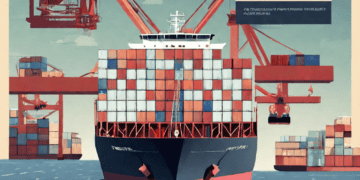In recent times, the repercussions of the ongoing trade discord between the United States and China have reverberated throughout various sectors of the supply chain, impacting stakeholders from raw-material suppliers to retail enterprises. The compelling nature of this situation urges U.S. companies to adopt proactive measures to safeguard their supply chains against the escalating volatility and uncertainty.
The complexity of this trade conflict has raised concerns among businesses, prompting a crucial need for strategic actions to alleviate potential risks. As companies navigate this terrain, there are pivotal steps that can be taken to mitigate these risks and ensure sustained operational stability.
Firstly, staying informed and vigilant about U.S.-China developments is paramount. The trade war has been characterized by a series of tariffs, retaliatory measures, and regulatory impositions, notably the Uyghur Forced Labor Prevention Act (UFLPA) leading to sanctions on goods linked to the Xinjiang Uyghur Autonomous Region. The evolving landscape demands continuous monitoring of trade policies and governmental actions from reliable sources such as the U.S. Department of Homeland Security and various trade councils to anticipate potential impacts and inform proactive decision-making.
Diversification of supply chains emerges as a critical strategy to counterbalance dependencies on China. The imposition of tariffs has incentivized U.S. companies to explore alternative sourcing destinations, with notable shifts towards countries like Vietnam and Mexico, witnessing substantial growth in imports and exports. Noteworthy examples like Apple diversifying its manufacturing base by establishing units in India exemplify this trend. Such diversification not only reduces reliance on a single market but also promotes localization and strategic inventory management.
Collaboration with suppliers is another vital aspect. Building transparency within supply chains, mapping nodes, and enhancing visibility into deeper tiers of the supply chain through collaboration and utilization of supply chain intelligence tools are essential. Establishing robust supplier relationship management teams becomes imperative to track developments, compliance, and identify new opportunities or risks.
Moreover, seeking support from government initiatives like the National Export Initiative and Trade Americas can provide valuable resources and guidance for businesses navigating these challenging waters. The strategic approach adopted by the U.S. government emphasizes investment in domestic industries, technology, and infrastructure, aligning with partners and allies to counteract Chinese trade maneuvers.
As uncertainties persist in the U.S.-China trade landscape, integrating technology-driven solutions becomes indispensable. Employing innovative tools to enhance agility, ensure compliance, and build resilience within the supply chain can be instrumental in navigating these tumultuous times.
In conclusion, amidst the complex dynamics of U.S.-China trade tensions, U.S. companies are presented with an opportune moment to fortify their supply chains. By monitoring developments, diversifying supply sources, collaborating with suppliers, and leveraging governmental support while embracing technology-driven solutions, businesses can effectively mitigate risks and build resilient supply chain frameworks for sustained success in a volatile global market.
Stay current with supply chain report news at The Supply Chain Report. For international trade resources, visit ADAMftd.com.
#USChinaTrade #SupplyChainRisks #TradeTensions #SupplyChainDiversification #BusinessStrategy #USChinaConflict #TradeWarImpact #Apple #VietnamTrade #MexicoTrade #SupplyChainManagement #ComplianceTools #SupplyChainVisibility #SupplierCollaboration #TechDrivenSolutions #ExportInitiative #ResilientSupplyChains #GovernmentSupport #OperationalStability #TradeUncertainty

















